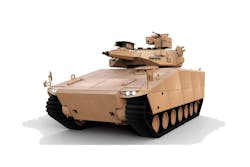Army planning to build new generation of armored combat vehicles: light tank and armored personnel carrier
THE AEROSPACE & DEFENSE BLOG – The U.S. Army has taken major steps forward in influential armored combat vehicles programs over the past couple of months in efforts to field a new light battle tank for infantry brigade combat teams and a future armored personnel carrier to replace the ageing M2 Bradley Fighting Vehicle.
In late June the Army awarded a $257.6 million order to General Dynamics Land Systems in Sterling Heights, Mich., for low-rate initial production of the M10 Booker -- a scaled-down version of the venerable Army M1A2 Abrams SEPv3 main battle tank.
Formerly known as the Mobile Protected Firepower (MPF) system, the M10 Booker primarily is to support infantry brigade combat teams on the battlefield, and is not intended to fight alongside the larger M1 Abrams main battle tanks in combined arms battalions.
The light tank has a 105-millimeter cannon, a 7.62-millimeter coaxial machine gun, externally mounted .50 caliber machine gun, and a 12.7-millimeter heavy machine gun. The M10's vetronics will include a commander’s independent tactical viewer to provide long-range panoramic targeting and enhanced situational awareness. This electro-optical system is the PASEO from Safran Optics 1 in Bedford, N.H.
The M10 has a lightweight hull and turret, and a modern diesel engine, transmission, and suspension system. Army leaders say they plan to create an M10 Booker battalion at the division level, from which M10 Booker companies will be allocated to infantry brigade combat teams; each infantry brigade combat team will have 14 M10 Bookers. Low-rate initial production (LRIP) describes small-quantity production of a new weapon system before large orders begin.
The M10 Booker has a four-person crew, and will target and destroy fortifications, bunkers, buildings, and light-to-medium armored vehicles. The lighter weight of the combat vehicle makes it more transportable and maneuverable than the full-size M1 Abrams tank. Army leaders plan to move the new light tank into full-scale production in 2025.
Also in June, the Army narrowed down the number of defense contractors seeking to design next-generation fast armored combat vehicles and vetronics architecture to replace the Army M2 Bradley Fighting Vehicle, naming two separate contracts collective worth $1.6 billion to American Rheinmetall Vehicles LLC in Sterling Heights, Mich.; and to General Dynamics Land Systems to build prototypes of the Optionally Manned Fighting Vehicle (OMFV).
The OMFV will be able to operate with or without a human crew, and will emphasize advanced electronics, machine autonomy for operating in unmanned mode, a 30-millimeter cannon, and a second-generation forward looking infrared (FLIR) sensor system for fighting at night, in bad weather, or in smoke and haze.
The OMFV also should have onboard embedded training systems, advanced power systems, reactive armor, active protection, artificial intelligence (AI), directed-energy weapons, and advanced target sensors.
The OMFV is part of a future family of armored combat vehicles encapsulated in the Next-Generation Combat Vehicle (NGCV) program to design several armored vehicles and vetronics to add new capabilities to Army units and replace existing platforms that are nearing the end of their service lives.
The NGCV program contains the OMFV to replace the Bradley Fighting Vehicle; the Armored Multi-Purpose Vehicle (AMPV) to replace the M113 armored personnel carrier; the Mobile Protected Firepower (MPF) light tank for Infantry Brigade Combat Teams (IBCTs); the Robotic Combat Vehicle (RCV) of three unmanned ground vehicles in light, medium, and heavy configurations; and the Decisive Lethality Platform (DLP), the replacement for the M1 Abrams main battle tank.
The M-2 Bradley, which the OMFV is to replace, has been in service since 1981. It moves infantry on the battlefield and provides fire support and attacks enemy armored fighting vehicles. The Bradley is reaching the technological limits of its capacity to accommodate new electronics, armor, and defense systems.
The C-17 cargo jet should be able to carry two OMFVs and have them ready for combat within 15 minutes of landing. The new vehicle should be able to fight in urban terrain, super-elevate weapons, and simultaneously engage threats using main gun and an independent weapons system.
About the Author
John Keller
Editor-in-Chief
John Keller is the Editor-in-Chief, Military & Aerospace Electronics Magazine--provides extensive coverage and analysis of enabling electronics and optoelectronic technologies in military, space and commercial aviation applications. John has been a member of the Military & Aerospace Electronics staff since 1989 and chief editor since 1995.
